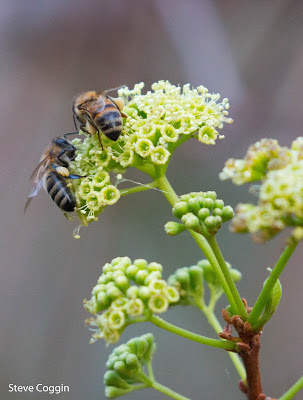The flora of Florida has a decidedly tropical feel. The further south you go the more tropical it gets. By the time you get to the Keys the plants are those of the West Indies. On a recent visit to the Keys we visited several hardwood hammocks and got to see these trees close up. One particular tree caught our attentions on several islands. It was Devil’s Claw (Pisonia aculeata). This small tree has a pantropical distribution but in the United States it is only found in South Florida and the Lower Rio Grande Valley of Texas.
 |
| Honey Bees (Apis mellifera) on Devil's Claw. The bees have collected pollen on their hind legs in pollen baskets. Key Deer National Wildlife Refuge, Florida. |
Devil’s Claw was in full flower in April. This tree produces abundant, tiny green flowers and attracts many pollinators. At the Key Deer National Wildlife Refuge on Big Pine Key we walked up on a Devil’s Claw and the first thing we noticed was the hum of dozens of Honey Bees (Apia mellifera). It is likely these bees were the Africanized Honey Bees (aka “Killer Bees”) since there are many colonies of these insects in Florida.
 |
| Honey Bees collecting nectar and pollen on Devil's Claw. Key Deer National Wildlife Refuge, Florida. |
Other insects were pollinating Devil’s Claw too. Two butterflies, the Florida Duskywing (Ephyriades brunnea) and the Hammock Skipper (Polygonus leo) were visiting the flowers. Florida Duskywings are small butterflies with the males a silky black and females mottled brown. Both sexes have tiny white spots on their forewings. These butterflies are found only in southern-most Florida, from the Everglades to Key West.
 |
| A male Florida Duskywing (Ephyriades brunnea), resting on a Cattail (Typha latifolia) leaf. Key Deer National Wildlife Refuge, Florida. |
 |
| A female Florida Duskywing pollinating Devil's Claw. Females have larger spots on the forewing than the males. Key Deer National Wildlife Refuge, Florida. |
Hammock Skippers are larger than Florida Duskywings, also very dark with three large white spots and three tiny white spots on the forewing. This butterfly is found across the southern tier of the United States.
 |
| Hammock Skipper (Polygonus leo) on Devil's Claw. Key Deer National Wildlife Refuge, Florida. |
Two odd, day-flying moths were also sipping nectar on Devil’s Claw. One was the Polka-dot Wasp Moth (Syntomeida epilais). Despite appearances it was a moth not a wasp. Its long wings and narrow waist do make it resemble a wasp and so scares off predators. In addition to looking like a wasp, this moth also has a graphic color pattern. The Polka-dot Wasp Moth’s wings are black with white spots, the abdomen is metallic blue with white spots and the tip of the abdomen is bright red. The bright colors shout a warning that this insect is chemically protected. The larvae feed on poisonous Oleander (Nerium oleander) and other plants in the same family. Polka-dot Wasp Moths concentrate the toxic cardiac glycosides of Oleander in the tissues of both the larvae and the adult.
 |
| Polka-dot Wasp Moth (Syntomeida epilais) visiting Devil's Claw. The feathered antennae show this mimic is a moth and not a wasp. Key Deer National Wildlife Refuge, Florida. |
The second interesting moth we found on Devil’s Claw has a wonderful name, Faithful Beauty (Composia fidelissima). This spectacular native of the West Indies and southern-most Florida has black wings with large white spots, the fore-wings are edged by bright red spots and the top of the abdomen and part of the hindwings are iridescent blue. The black body of these moths is striped with white. As you would expect by the colors, these moths bear a load of noxious chemicals. Faithful Beauty caterpillars feed on some of the same plants as the Polka-dot Wasp Moth and the adults retain the toxic chemicals that protect them from bird predators.
 |
| Faithful Beauty and Honey Bee sharing an inflorescence of Devil's Claw. Key Deer National Wildlife Refuge, Florida. |
It was great to see this one native tree feeding a host of pollinating insects including some spectacular ones that are rarely seen outside the Florida Keys. With all the invasive plants and animals in South Florida it was heartening to find an intact piece of this ancient ecosystem.
 |
| Faithful Beauty and Honey Bees on Devil's Claw. The bold colors and pattern of this moth advertise that it is chemically protected. Key Deer National Wildlife Refuge, Florida. |

No comments:
Post a Comment